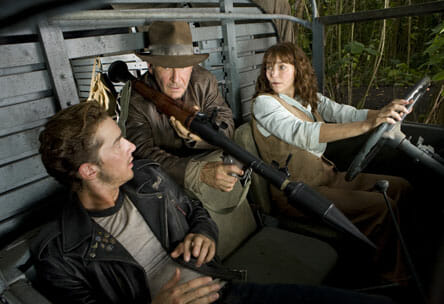Indiana Jones and the Kingdom of the Crystal Skull

Release Date: May 22
Director: Steven Spielberg
Writer: David Koepp, (story by George Lucas and Jeff Nathanson) Cinematographer: Janusz Kaminski
Starring: Harrison Ford, Cate Blanchett, Karen Allen, Shia LaBeouf
Studio/Run Time: Paramount Pictures and Lucasfilm, 124 mins.
Indiana Jones has neither swashed nor buckled on the big screen in 19 years, but he’s back in Indiana Jones and the Kingdom of the Crystal Skull, which appropriately takes place 19 years after the last film. It’s now 1957, and Indy has aged along with his fans and, more importantly, the actor who plays him. But, aside from a couple of jokes about his age, you’d hardly know it. He still throws—and takes—more punches than the rest of the world’s archaeologists combined, but surprisingly, Harrison Ford, now 66, looks neither computer generated nor out of place in these fist fights. Whether it’s done with the latest technology or just fancy stunt work, the action in Crystal Skull has an almost antiquated realness, an art that I thought was lost in the embrace of CGI.
The film is fun, but it doesn’t hold a torch to the original. It’s too busy reconnecting severed ties and repeating our favorite bits, but it comes closer to capturing the magic of Raiders of the Lost Ark (1981) than the other sequels did, and parts of it are more thrilling than anything else in the entire series.
The plot involves an elongated crystal skull that looks like a glass rendering of Ridley Scott’s alien. Naturally, everyone wants it (wouldn’t you?), not because it looks like it’s filled with wads of useful cellophane but because whoever returns the skull to the temple from whence it came gets some sort of unimaginable reward, one that doesn’t seem to be monetary. The Soviets, like the Nazis who pursued the Ark of the Covenant in the first film, want the skull for nefarious purposes. Beyond this outline, the story is a tangle of barbed wire that hardly seems worth the bloody fingers it would take to straighten it, and screenwriter David Koepp doesn’t expect us to. Every once in a while someone sums everything up (“He’s telling us to look in Peru!”), and then the film dissolves to a map and follows a red line to an exotic new locale.
-

-

-

-

-

-

-

-

-

-

-

-

-

-

-

-

-

-

-

-

-

-

-

-

-

-

-

-

-

-

-

-

-

-

-

-

-

-

-

-








































